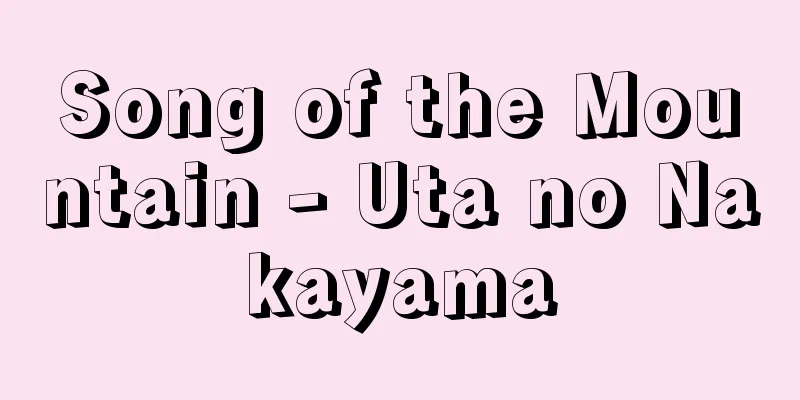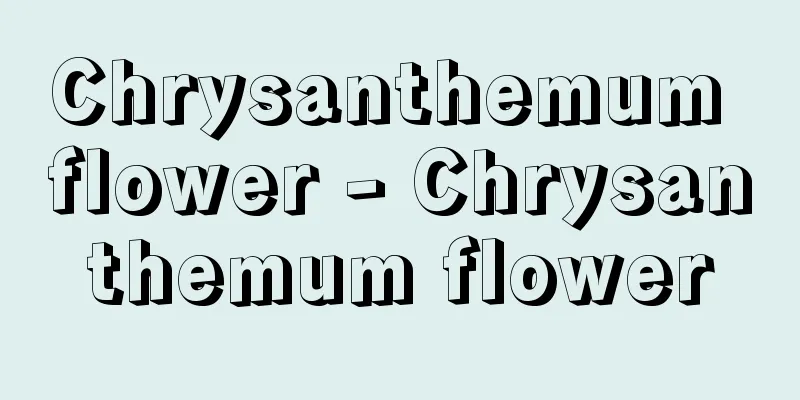Mandala

|
Mandala is a Sanskrit word that combines maa, meaning essence, essence, or essence, and la, the suffix indicating possession. It indicates the perfection of the past passive participle, so it means "something that possesses the essence" or "something that illustrates or illustrates the essence." In Buddhism, it is translated as dan in the old translation and rinengusoku or shuju in the new translation. Mandalas are central to the ritual implements of esoteric Buddhism and fall into the category of Buddhist paintings, but they were not originally made in Japan; they were brought back from China by Kukai along with scriptures. In Chinese, they are transliterated as "mandala" or "mandala." When classified according to the method and purpose of use, they are broadly divided into Ryogai mandalas and Besson mandalas. However, Pure Land Buddhist paintings of Pure Land transformations are also called mandalas. In addition, the expression of mandalas as a cosmic phenomenon and a form-theoretic explanation is divided into four types: the Great Mandala, the Sammaya Mandala, the Law Mandala, and the Karma Mandala, which are abbreviated as "Dai-San-Ho-Katsuma" and are called the Four Mandalas. This is the theory of Kukai, but the basis is found in the "Mahavairocana Sutra" (Mahavairocana Sutra), in the Honzon Samadhi-bon (Samadhi Chapter). (1) Maha-mandala (Great Mandala). This refers to paintings, sculptures, and crafts that depict the entire universe as the Buddhas and Bodhisattvas (embodiments of the six elements) and are given the colors of the five elements. (2) Samaya-mandala: The various implements held by the various deities represent the Buddha's original vow, and so only the implements such as the sword, the wheel, and the lotus are expressed as symbols. (3) Dharma Mandala The Dharma Mandala represents the various deities using seed letters (Sanskrit characters) and mantra characters. (4) Karma-mandala. It regards the movement of the universe as a symbolic expression of reality, and depicts various deities in three dimensions using wood, bronze (or iron), or clay statues. [Toshiaki Manabe] Mandala of Both WorldsThe Ryōkai mandalas of esoteric Buddhism are all large (1 to 3 meters in length and width) and are placed inside (the inner sanctuary of) a relatively large building called the Kondo or Kanjō. There are two types of mandalas: hanging scrolls and laid mandalas that are laid on a platform. Today, it is customary for even the smallest Shingon Buddhist temples to have one or two mandalas on hand at all times. The one that hangs on the right, east side when facing the front, is called the Taizōkai (properly speaking, the Garbha) mandala. This is an illustration based on the Mahavairocana Sutra, and represents the world of reason based on the feminine principle, or a materialistic worldview. Also hanging on the left, west side, is called the Vajrayana Mandala, and is illustrated based on the Vajrasekhara Sutra, representing the world of wisdom, or a spiritual worldview, based on the masculine principle. The two are accompanied by separate platforms, and the overall concept of the hall is to place a non-two platform in the middle of both. This central mediator establishes the theory that the function of reason in the East and the function of wisdom in the West are originally "one" (nini-funi). If you think about it, every existence in this world has two opposing concepts at work, and one of them cannot exist alone. The two worlds of the mandala, namely "reason" and "wisdom," are also two sides of the same coin in terms of their virtue (function). The highest state of enlightenment in esoteric Buddhism, which teaches that humans can become Buddhas while still alive in this world, that is, instantaneous enlightenment, is said to be possible only when the Garbhakai and Vajrayanakai (abbreviated as Taikon or Kontai) are fused together. In that sense, the Mandala of Both Worlds has absolute value. The paintings of the Womb and Diamond Realms create a beautiful and well-balanced world filled with an indescribable deep harmony. Its transcendent beauty is similar to the beauty that resides in a healthy human body (male and female). Furthermore, it is not only the human body, but all living things can be seen as mandalas. [Toshiaki Manabe] Womb MandalaThe Garbha Mandala is based on the Mahavairocana Sutra and is composed of twelve groups of major groups. A total of 410 Buddha statues are depicted in the mandala. The composition of the twelve groups is as follows: [1] Chudai Hachiyoin Located in the center of the painting, it has a large depiction of Dainichi Nyorai (Mahavairocana) on a lotus pedestal in the center. On the eight petals of a red lotus, four Buddhas are placed on all four sides and four Bodhisattvas are placed in the four corners. The eight petals of the lotus, which form the base of the painting, are called the eight-petaled fleshy heart (nikudanshin) in ancient Indian medical texts, and represent the heart that everyone has. In this way, it is a stage where all living beings can be transformed into the world of Buddha in this real world. The eight petals that spread out in all eight directions are the starting point for blood flowing through the eleven surrounding temples. The purpose of this place is to be a place where religious awakening can be obtained, corresponding to the blessings of forces that work and pull each other. [2] Henchiin Temple Located just above the center, if Dainichi Nyorai is a living Buddha, this is the place where he utilizes his intelligence, which can also be called his brain. The symbol of a triangle and a swastika, called Issai Nyorai Ichiin (All-Pervasive Wisdom Seal), is expressed here. This symbol represents reason and contains within it the human ability to recognize things. [3] Rengebuin (Kannonin): This is a place where the group of Kannon Bodhisattva, who have built up intellectual wisdom up to Henchiin, can be further enhanced through compassion from the sensory side. [4] Kongo-buin: Compared to the Lotus-buin, this is the control department that further develops the intellect, eliminates delusion, and enables superior wisdom. [5] The Five Great Temples: They have the function of unifying the great compassion and wisdom of the Lotus and Kongo temples. They therefore chant mantras such as Acala and engage in arduous training. [6] Shakain Temple: Shakyamuni appears as a transformed form of Dainichi Nyorai and preaches the Dharma as the temporary protagonist. [7] Jizo-in Temple: Located to the left of the Renge-bu-in Temple, its function is closely related to that of the Kannon Bodhisattva, who, through her mercy, places the deity in one of the six paths of existence (hell, hungry ghosts, animals, asuras, humans, and heaven), and serves to save those who are lost. [8] Kokuzoin Temple: The world where the wish for happiness and profit of Bodhisattva Koku is realized. [9] Jogaishoin: Located to the right of Kongobuin, this temple has the power to remove worldly desires. [10] Monjuin Temple: This represents the wisdom of Manjusri Bodhisattva and the refinement of human cognition to the highest level. [11] Soshitsujiin Temple: Located beneath Kokuzoin Temple, this temple serves as a pilot to guide people to the state of enlightenment. [12] Gekongobu-in (Outer Vajrayana Temple), also called Saigein (External Temple), depicts all the forms and circumstances of the cycle of reincarnation in the six realms (which change but never perish). It depicts a scene that explains and suggests that this and the completed Mahavairocana Buddha in the center are ultimately equal in terms of values. [Toshiaki Manabe] Diamond Realm MandalaThe Vajrayana Mandala is based on the Vajrayana Sutra, and is composed of nine sections called Kue. It features a total of 1,461 Buddha statues and symbols called Sammaya-gyo. From the Womb onwards, the screen and composition are neatly divided and simple. Below, we will look at the nine sections in the order in which the mandala should be contemplated. [1] Jojinne (the First Coming of Age) Also called Katsumae (the First Coming of Age), it is the center of all (worldly) activities. The main figures are 37 Buddhas, including those of mutual offering, drawn vertically and horizontally. [2] Sammaya-e: A place that teaches communication between humans and Buddhas, represented only with symbols such as pagodas and vajra. [3] Misaie: The Buddha is depicted inside a vajra, showing a person entering into the interior of the mandala while meditating. [4] Memorial Service: This depicts the mutual memorial service between Dainichi Nyorai and the Buddhas of the four directions, and explains its significance. [5] Shiinne [7] Rishu-kai In the rituals of Esoteric Shingon Buddhism, a mandala is hung in front of the body and a platform is set up in front of it to perform the ritual. The ritual is accompanied by direction, gestures, ritual implements, and music such as chanting. In the space of the inner sanctuary where the ritual is performed, a beautiful fusion of sound, scent, and the dazzling five-colored "colors" that enter through the eyes is presented. The ancient people of Japan must have been intoxicated by the solemnity of this ritual, in which the three-dimensional mandala was combined with the performance of the ritual. Training in Esoteric Buddhism means entering the world of the mandala. It means immersing yourself in the colors, sounds, gestures, movements, and even the smells. [Toshiaki Manabe] Besson MandalaBesson Mandalas are individual statue mandalas created based on the many worldly benefits of esoteric Buddhism, and are the principal image of the Besson Dharma for which prayers and rituals are performed. There are many mandalas in existence, divided into Buddha, Bodhisattva, Myo-o, Heavenly Being, and sutras. The principal image that meets the prayer of the worshipper (e.g. Ichiji Kinrin Butcho) is placed in the center, and seven treasures are painted around it. At the same time, the Ichiji Kinrin Dharma was performed, and nobles, relatives, and family members would pray in front of this Besson Mandala for rain to stop, illness to be cured, and long life to come. There are more surviving examples of Besson Mandalas from the Heian and Kamakura periods than there are of Ryōkai Mandalas, including the handed down Shakyamuni Mandala, the Kokuzo Mandala, the Buddha's Eye Mandala, the Sonshō Mandala, the Ichiji Kinrin Mandala, the Lotus Sutra Mandala, the Dojikyō Mandala, These include the Treasure Tower Mandala, the Niōgyō Mandala, the Miroku Mandala, the Eight-Sided Mandala, the Aizen Mandala, the Star Mandala, the Kichijōten Mandala, the Enma-ten Mandala, and the Twelve Mandalas. [Toshiaki Manabe] Tibetan MandalaThe Mahavairocana Sutra, the original source of the Mandalas of Both Realms, is said to have been translated into seven volumes in Chinese, but the Sanskrit version (undiscovered) is thought to have been created in the mid-7th century or earlier in North India. Only the first of the 18 100,000 verses of the Vajrasekhara Sutra has been handed down in Chinese translation, and the Sanskrit version (partially discovered) is said to have been created in Central or South India in the late 7th century. Most Tibetan mandalas are of the Vajrasekhara Sutra type mentioned above, and their ancient forms have been handed down in Western Tibet (Ladakh). In terms of style, mandalas based on the following classifications are considered: (1) Shosa Tantra, (2) Ascetic Tantra, (3) Yuka Tantra, and (4) Anuttara Tantra. However, (1) is rarely found in the Sadanho method, and (2) is rarely found in the Mahavairocana Sutra. The center of [3] is the Vajrayana Mandala, which remains as 13 colored murals in the three-story hall of the Geruk sect's Alchi Gompa in Alchi village (west of Gle in western Tibet) (dating from the 13th to 15th centuries). Other mandalas in Ladakh include the mandalas of Purity of the Evil Realms, Dainichi the All-Knowing, Shakyamuni, and Perfection of Wisdom. [4] is a mandala of the Father Tantra system, in which the central figure is accompanied by a consort. In the Mother Tantra system, there are the mandalas of Dharmakaya Samantabhadra, Vajra, Hevajira, Savara, and Vajrabharahi. A few mandalas of the Funi Tantra type have also been preserved. Some of these are murals, but most are painted with mud paint in the form of thangkas (picture scrolls). However, in recent years, many of the high-quality works have been exported overseas. The painting techniques are classified into Indian, Kashmir Guge, Central Asian, Chinese Kham, and Tibetan styles. There are also a few three-dimensional mandalas (Lulan Khinkor blos bsla dkyil khor) that require advanced techniques, but these are in the form of a pagoda (Chuten), and are symbols of Tibetan mandalas that contemplators regard as the truth of the universe and the giant Buddha body. [Toshiaki Manabe] Other MandalasThere are various forms of mandalas, and the famous Javanese Buddhist site Borobudur is a three-dimensional mandala of Samantabhadra, a Caitya stupa, and has been interpreted as a Dharma Mandala. Furthermore, the illustrated, three-dimensional form (craft) that embodies the worldview of mandalas as Indian religious consciousness is also used in Hindu Tantra. In particular, the yantra, also called a cakra, combines the true nature of the universe with the nature of the mind, and is similar to the wheel-en-gusoku style of the mandala. [Toshiaki Manabe] Mandalas and the Modern EraSince ancient times in India, mandalas have been positioned in the cosmic dimension, and self-nature (person) is compared to the microcosm in comparison to the macrocosm. Self-nature is the source of energy for limitless activity, and the macrocosm and microcosm are formed as the stage for mandalas from the circumstances in which that power is emitted. The relative positioning of mandalas can be considered as "the world of the idea of Dharmakaya Dainichi (self-nature mandala), but from the standpoint of us practitioners or cognitive subjects, it is ultimately our own microcosm (contemplation mandala) and the schema of phenomena (image mandala)" (Kanaoka Hidetomo's theory). Moreover, in recent research, there is a movement to further raise the philosophical level of mandalas within the epistemology of esoteric Buddhism by using computer graphics, and to embody and practice the essential theory of mandalas. Furthermore, the interest in mandalas in modern times has tended to take on a life of its own amid the boom in esoteric Buddhism, such as the works of Kukai, and the meaning of the word has been expanded in various fields. In particular, mandalas play the role of a tool that connects both the material and the spiritual. An example of this application is book design using mandalas as material (Kohei Sugiura and others). There are also many contemporary musical works, such as mind music, that use synthesizers to compose cosmic space based on mandala theory (Toshiro Mayuzumi, Kitaro and others). In modern painting, the form, color and structure of mandalas are used in the drawings (Tsunemasa Maeda and others). They have also influenced theater (avant-garde works), dance, fashion, film (Akio Jissoji and others), flower arrangement (some Shogetsudo Koryu), video art and meditation. [Toshiaki Manabe] "Studies on Esoteric Mandalas" by Manabe Toshiaki (1970, Bijutsu Shuppansha)" ▽ "The World of Mandala Beauty" by Manabe Toshiaki (1980, Jinbun Shoin)" ▽ "The Art of Mandalas" by Manabe Toshiaki (1981, Shogakukan)" ▽ "Studies on Mandalas" by Ishida Naotoyo (1975, Tokyo Bijutsu)" ▽ "The World of Mandalas" by Hamada Takashi (1979, Bijutsu Shuppansha)" ▽ "Mandalas" by Matsunaga Yukie (1981, Mainichi Shimbun)" ▽ "Studies on Mandalas" by Toganoo Shoun (1982, Koyasan University Esoteric Culture Research Institute)" ▽ "Buddhas of Mandalas" by Yorimoto Motohiro (1985, Tokyo Bijutsu)" ▽ "The Gods of Mandalas" by Tatekawa Musashi (1987, Arina Shobo)" ▽ "Mandala Iconology" by Tanaka Kimiaki (1987, Heikawa Publishing)" ▽ "The Philosophy of Esoteric Buddhism" by Kanaoka Hidetomo (1989, Heirakuji Shoten)" ▽ "Illustrated: How to View Mandalas" by Komine Yahiko (1997, Daihorinkaku)" ▽ "The Birth of the Mandala of Both Realms" by Tanaka Kimiaki (2004, Shunjusha)" [References] | | | | | | | |©Shogakukan "> Name of each Ryokai Mandala (Vajra World) association ©Shogakukan "> Names of each chapter of the Mandala of the Two Realms (Tanzoukai) Source: Shogakukan Encyclopedia Nipponica About Encyclopedia Nipponica Information | Legend |
|
曼荼羅はサンスクリット語でmandalaといい、本質、心髄、醍醐(だいご)を意味するマンダmaaと所有を表す接尾辞ラlaを合成した語である。過去受動分詞の完了を示すので、「本質を所有するもの」「本質を図示・図解するもの」の意である。仏教では、旧訳(くやく)で壇(だん)、新訳で輪円具足(りんえんぐそく)、聚集(しゅうじゅう)と訳す。 マンダラは、密教の法具の中心で仏画のジャンルに入るが、元来日本でつくられたものではなく、空海が中国から経典などとともに持ち帰った請来(しょうらい)品である。漢文で「曼荼羅」「曼陀羅」などと音訳する。用途の方法、目的によって分類すると、大きく両界(りょうがい)曼荼羅と別尊(べっそん)曼荼羅に分けられる。ただし浄土教絵画の浄土変相図も曼荼羅と呼称する。 また、宇宙の現象および形相論的説明として曼荼羅の表現を4種に分ける。すなわち、大(だい)曼荼羅、三昧耶(さんまや)曼荼羅、法(ほう)曼荼羅、羯磨(かつま)曼荼羅で、略して「大・三・法・羯」といい、四(し)曼荼羅という。空海の所説であるが、根拠は『大日経(だいにちきょう)』本尊三昧品(さんまいぼん)にある。 (1)大曼荼羅 マハー・マンダラmaha-maala。宇宙の全体を諸仏諸菩薩(ぼさつ)と見立て(六大の当体として表現)五大の色を与えられて表現した絵画、彫刻、工芸品の類をいう。 (2)三昧耶曼荼羅 サマヤ・マンダラsamaya-maala。諸尊の所持する種々の器具は仏の本誓(ほんぜ)を表すものであるから、その刀剣、輪宝(りんぽう)、蓮華(れんげ)などの器具のみをシンボルとして表現する。 (3)法曼荼羅 ダルマ・マンダラdharma-maalaは諸尊を種子(しゅじ)(梵字(ぼんじ))、真言(しんごん)の文字で表す。 (4)羯磨曼荼羅 カルマ・マンダラkarma-maala。宇宙の動きを実在の象徴的表現とみなし、立体的に諸尊を木造、銅造(鉄も)塑像などで表現する。 [真鍋俊照] 両界曼荼羅密教の両界曼荼羅は、いずれも大幅(縦・横1メートルから3メートル余)で、金堂あるいは灌頂堂(かんじょう)という比較的大きい建物の内部(内陣)に安置される。これにも2種あり、掛幅(かけふく)用と壇上に敷く敷(しき)曼荼羅に分けられる。今日では真言宗の寺院ならどんな小さなところでも、曼荼羅の1、2本はかならず常備しているのが通例である。正面に向かって右、東側に掛けるのを胎蔵界(たいぞうかい)(正しくは胎蔵)曼荼羅という。これは『大日経』を所依として図解したもので、女性的原理に基づく理の世界、あるいは物質的な世界観を表す。同じく向かって左、西側に掛けるのを金剛界(こんごうかい)曼荼羅といい、『金剛頂経』を所依として図解し、男性的原理に基づく智(ち)の世界、あるいは精神的な世界観を表す。 両者に添える壇は、おのおの別々に設けられており、堂全体の構想としては両方の真ん中に不二壇(ふにだん)を配置する。この中央の仲立ちによって、東の理の働き(機能)と西の智の働き(機能)はもともと「一つ」(二而不二(ににふに))にほかならない、と理論を組み立てるのである。考えてみれば、この世のあらゆる存在には、異なる二つの対立概念が働き合っており、その片方だけでは単独で成り立たない。曼荼羅の両界すなわち「理」と「智」も、その徳(働き)において表裏一体の関係にある。人間がこの世に生きながら仏になれると説く密教の最高の悟りの境地、つまり即身成仏(じょうぶつ)も、この胎蔵界と金剛界(胎金(たいこん)あるいは金胎(こんたい)両部と略称する)が融合していることによって可能になるという。その意味において両界曼荼羅は絶対的な価値を有する。胎蔵界と金剛界の画面は、えもいわれぬ深い調和に満ち美しく均整のとれた世界を画面上につくりだしている。その超絶的な美しさは、いってみれば、人間(男と女)の健康な肉体に宿る美しさにも似ている。さらにいえば、人間の身体ばかりでなく、生きとし生ける「もの」すべてを曼荼羅とみてみられないことはない。 [真鍋俊照] 胎蔵曼荼羅胎蔵曼荼羅は『大日経』所説のもので、十二大院のグループから構成されている。仏像は曼荼羅内に合計410尊を描いている。十二大院の構成は次のとおりである。 〔1〕中台八葉院(ちゅうだいはちよういん) 画面の中央にあり、中心には蓮台(れんだい)の上に大日如来(にょらい)を大きく描く。八葉の赤い蓮華の花びらの上には四方四仏と四隅に四菩薩を配置している。ベースになっている八葉の蓮弁は、古代インドの医学書によると八弁の肉団心(にくだんしん)とよばれ、だれもがもっている心臓を表している。そのように、衆生(しゅじょう)(だれでも)が現実のこの世において仏の世界に置き換えられるような舞台である。その八方に広がる八弁は、周辺の十一院に血を通わせる出発点である。ここの目的は、力が働き合い、引っ張り合う加持(かじ)相応の宗教的な覚醒(かくせい)を得る場所である。 〔2〕遍智院(へんちいん) 中央のすぐ上にあり、大日如来が生仏(いきぼとけ)であるならば、その頭脳ともいうべき知慧(ちえ)を活用させるところである。ここには一切如来智印(いっさいにょらいちいん)(一切遍智印)とよぶ三角形と「まんじ」(卍)のシンボルが表現されている。このシンボルは理性を表し、人間の認識能力を内に秘めている。 〔3〕蓮華部院(れんげぶいん)(観音(かんのん)院) 観音菩薩のグループで、遍智院まで築き上げてきた頭脳的な知慧を感性の方面から慈悲によって高めてゆく場所。 〔4〕金剛部院(こんごうぶいん) 蓮華部院に対し知性の方面からさらにはぐくみ、迷いを断ち、優れた智慧を働かせるコントロール部門。 〔5〕五大院 蓮華部院と金剛部院の大悲および知慧を統一する働きをもつ。したがって不動明王などの真言(マントラ)を唱えて実際に苦しい修行をする。 〔6〕釈迦院(しゃかいん) 大日如来の変化(へんげ)した姿として釈迦が登場、仮の主役として法を説いてゆく。 〔7〕地蔵院 蓮華部院の左隣にあり、その機能も大いに関連する。つまり観音の慈悲に徹して、身を六道(地獄・餓鬼(がき)・畜生(ちくしょう)・修羅(しゅら)・人間・天上)に置き、迷う人々を救済する役割を果たす。 〔8〕虚空蔵院(こくうぞういん) 虚空菩薩の福徳(幸福と利益)の願いを実現する世界。 〔9〕除蓋障院(じょがいしょういん) 金剛部院の右隣にあり、煩悩(ぼんのう)を取り除く作用をもつ。 〔10〕文殊院(もんじゅいん) 文殊菩薩の知慧を表し、人間の認識作用をもっとも高いレベルにまで仕上げてゆく。 〔11〕蘇悉地院(そしつじいん) 虚空蔵院の下にあり、人間を「悟り」の境地に案内するパイロットの役目をもつ。 〔12〕外金剛部院(げこんごうぶいん) 最外院(さいげいん)ともいい、六道の輪廻(りんね)(移り変わっても永久に滅びない)のすべての姿、状況がうつし出されている。これと中心の完成された大日如来とは、価値観において終局的に等しいということを説明し示唆する場面を描く。 [真鍋俊照] 金剛界曼荼羅金剛界曼荼羅は、『金剛頂経』所説のもので、画面を九会(くえ)とよび、九つに区画されたグループから構成されている。仏像と三昧耶形(さんまやぎょう)とよぶシンボルが描かれ、合計1461尊ある。胎蔵より画面・構成図は整然と区分され、シンプルである。以下、九つのセクションを、曼荼羅を観想(かんそう)する順にみてゆくことにする。 〔1〕成身会(じょうじんね) 羯磨会(かつまえ)ともいい、すべて(この世)の活動の中心となる。主役は縦・横に描かれた相互供養(くよう)の仏など37尊。 〔2〕三昧耶会(さんまやえ) 宝塔や金剛杵(こんごうしょ)などのシンボルのみで表現し、人間と仏と交感することを教える場所。 〔3〕微細会(みさいえ) 仏を金剛杵の中に描き、人間が瞑想(めいそう)しながら曼荼羅の内部に入ってゆくことを示す。 〔4〕供養会(くようえ) 大日如来と四方の仏たちと相互供養するようすを描き、その意義を教える。 〔5〕四印会(しいんね) 〔7〕理趣会(りしゅえ) 真言密教の儀式では、曼荼羅を眼前に掛け、前方に壇を設けて修法を行う。その儀式には、方位、所作、法具、それに声明(しょうみょう)などの音楽が伴う。儀式を儀式を行う内陣の空間には、音声と香りと目から入る五彩絢爛(けんらん)な「彩色」の融合の美しさが提示されるのである。わが国の古代の人々は、この立体的な曼荼羅に修法の演出が加味された儀式の荘厳なさまに陶酔したに違いない。密教でいう修行とは、まさに曼荼羅の世界の中に入ることである。それは、色彩の中に、音声の中に、所作、動作の中に、さらに、においの中にも自分自身が入り込むことである。 [真鍋俊照] 別尊曼荼羅別尊曼荼羅は、密教の数多くの現世利益(げんぜりやく)に基づいて製作された個別の尊像曼荼羅で、祈祷(きとう)・修法を行う別尊法の本尊である。仏部、菩薩、明王、天部や経法(きょうぼう)に区分けされて、数多くの曼荼羅が現存する。中央に礼拝者の祈願にかなう本尊(例、一字金輪仏頂(いちじきんりんぶっちょう))配置し、周囲に七宝(しっぽう)が描かれる。同時に一字金輪法を行じ、この別尊曼荼羅の前で公家(くげ)、縁者一族などが止雨、除病、延寿を祈った。 別尊曼荼羅の現存する平安・鎌倉時代の作例は両界曼荼羅より比較的多く、伝釈迦曼荼羅図、虚空蔵曼荼羅図、仏眼曼荼羅図、尊勝曼荼羅図、一字金輪曼荼羅図、法華(ほっけ)曼荼羅図、童子経曼荼羅図、宝楼閣曼荼羅図、仁王経曼荼羅図、弥勒(みろく)曼荼羅図、八字文殊曼荼羅図、愛染(あいぜん)曼荼羅図、星(ほし)曼荼羅図、吉祥天曼荼羅、閻魔天(えんまてん)曼荼羅図、十二曼荼羅図などがある。 [真鍋俊照] チベットの曼荼羅両界曼荼羅の原本となった『大日経』は7巻の漢訳が伝えられているが、サンスクリット本(未発見)は7世紀中ごろまたはそれ以前に北インドの地方で成立したと考えられている。『金剛頂経』は十八会十万頌あったうち初回のみが漢訳等で伝えられ、サンスクリット本(一部分発見)は7世紀後半に中・南インドで成立したという。チベットの曼荼羅は前述の金剛頂経系のものが大部分で、その古様の形式が西チベット(ラダック)に伝存している。様式的に〔1〕所作(しょさ)タントラ、〔2〕修行タントラ、〔3〕瑜迦(ゆが)タントラ、〔4〕無上瑜迦タントラの分類に基づく曼荼羅が考えられる。しかし、〔1〕は作壇法(さだんほう)など、〔2〕は『大日経』でともにほとんどない。〔3〕の中心が金剛界曼荼羅で、アルチ村(西チベットのレーGleの西)にあるゲールック派のアルチ・ゴンパ三層堂に13壁画の彩色画で残っている(時代は13~15世紀ころ)。ほかにラダックには悪趣清浄、一切智(いっさいち)大日、釈迦、般若波羅蜜(はんにゃはらみつ)の曼荼羅がある。〔4〕は父(ふ)タントラ系の曼荼羅で、中尊は明妃(みょうひ)(配偶神)を伴う。母(も)タントラ系では法身普賢(ほっしんふげん)、持金剛、ヘーバジラHevajira、サンバラSavara、バジラバーラーヒーVajrāvārahīの曼荼羅がある。ほかに不二(ふに)タントラ系の曼荼羅も若干、伝存する。これらのものは壁画もあるが、大部分はタンカ(画軸)の形式で泥絵の具で描かれる。しかし、近年、良質の作品は国外に流出したものも多い。画法はインド様式、カシュミール・グゲ様式、中央アジア様式、中国カム(康)様式、チベット様式に区分される。なお高度な技術を要する立体曼荼羅(ルーラン・キンコルblos bsla dkyil khor)も若干現存するが、これは仏塔形式(チューテン)のもので、観想するものが大宇宙の真理と巨大な仏身とみなすチベット曼荼羅のシンボルである。 [真鍋俊照] その他の曼荼羅曼荼羅の形態は種々あり、有名なジャワの仏跡ボロブドゥールも、普賢金剛薩埵(ふげんこんごうさった)の立体曼荼羅であり、仏塔のチャイトヤCaityaであり、法界曼荼羅などの解釈がある。さらに曼荼羅の世界観をインドの宗教的意識として具現した図示・立体的な形態(工芸品)ではヒンドゥー教タントラでも用いられている。とくにヤントラyantraは、チャクラcakraともいい、宇宙の真実の相と心の相を組み合わせたもので、曼荼羅の輪円具足の趣(おもむき)に近似する。 [真鍋俊照] 曼荼羅と現代曼荼羅は宇宙的次元に位置づけることにより、インド古来より大宇宙macrocosmosに対し自性(人)を小宇宙microcosmosにあてる。自性は限りない活動のエネルギーの源点であり、その力の発する状況から、曼荼羅の舞台として大宇宙と小宇宙が成り立っている。その相対的な曼荼羅の位置づけは「法身大日のイデアの世界(自性曼荼羅)であるとともに、われわれ実践者ないし認識主体の立場からみれば、それはあくまでもわれわれ自身のミクロ・コスモス(観想曼荼羅)であり、現象のシェーマ(形像曼荼羅)なのである。」(金岡秀友説)とみなすことができるという。しかも近年の研究では、密教の認識論のなかで曼荼羅の本質的な理論を、コンピュータ・グラフィクスを使いながら曼荼羅の哲学的レベルをさらに引き上げ、具現化し実践しようとする動きもある。 また、現代における曼荼羅への関心は、空海の著作等の密教ブームのなかでひとり歩きする傾向がみられ、さまざまな分野で語義のイメージ展開が行なわれている。とくに物質と精神の両面を結び付ける用具の役割も果たしている。その応用例をあげると、曼荼羅を素材にしたブックデザイン(杉浦康平ほか)がある。また現代のマインドミュージックなど音楽作品にシンセサイザーを使い宇宙空間を曼荼羅理論によって作曲したものも多い。(黛敏郎(まゆずみとしろう)、喜多郎(きたろう)ほか)。現代絵画では曼荼羅の型、彩色、構造などを作画のなかに展開している(前田常作ほか)。このほか演劇(前衛的なもの)、舞踏、ファッション、映画(実相寺昭雄ほか)、いけ花(松月堂古流の一部)、ビデオアート、メディテーションに影響を与えている。 [真鍋俊照] 『真鍋俊照著『密教曼荼羅の研究』(1970・美術出版社)』▽『真鍋俊照著『曼荼羅美の世界』(1980・人文書院)』▽『真鍋俊照著『曼荼羅の美術』(1981・小学館)』▽『石田尚豊著『曼荼羅の研究』(1975・東京美術)』▽『濱田隆著『曼荼羅の世界』(1979・美術出版社)』▽『松長有慶著『マンダラ』(1981・毎日新聞社)』▽『栂尾祥雲著『曼荼羅の研究』(1982・高野山大学密教文化研究所)』▽『頼富本宏著『マンダラの仏たち』(1985・東京美術)』▽『立川武蔵著『曼荼羅の神々』(1987・ありな書房)』▽『田中公昭著『曼荼羅イコノロジー』(1987・平河出版社)』▽『金岡秀友著『密教の哲学』(1989・平楽寺書店)』▽『小峰彌彦著『図解・曼荼羅の見方』(1997・大法輪閣)』▽『田中公明著『両界曼荼羅の誕生』(2004・春秋社)』 [参照項目] | | | | | | | |©Shogakukan"> 両界曼荼羅(金剛界)各会名称 ©Shogakukan"> 両界曼荼羅(胎蔵界)各会名称 出典 小学館 日本大百科全書(ニッポニカ)日本大百科全書(ニッポニカ)について 情報 | 凡例 |
<<: Mandala offering - Mandala
Recommend
Kinkei Academy
It was a nationalistic educational organization f...
Penzias, AA (English spelling) PenziasAA
…It is also called 3K radiation because the stren...
Uesugi Zenshu
?-1417 A military commander of the Muromachi peri...
Kanbe Sadanaga
...Also called Isemachi Magistrate, Isegundai, Is...
Kemble - John Philip Kemble
English actor. He was the eldest son of Roger Kem...
Secondary wave
…They do not travel through liquids. They travel ...
Odo of Bayeux
[Born] Around 1036 [Died] 1097. Palermo English cl...
Umekita Uprising
On June 15, 1592 (Bunroku 1), Shimazu retainer Ume...
Playground - Sports ground
A specific location equipped with the equipment a...
Solution - Ketsuge
〘 noun 〙 ("ge" is the Go-on pronunciatio...
Gensuke Kiyohara
A poet of the mid-Heian period. He was the grands...
Remote psychic response
…One of the paranormal phenomena. It is translate...
Asama no Okami - The Wolf of Asama
…The oldest document on Mount Fuji, the Fujisan-k...
Inano Omura
A high-ranking official in the Asuka period. He w...
Mucopolysaccharide - Mucopolysaccharide (English spelling)
A general term for polysaccharides containing ami...







![Yachiyo [town] - Yachiyo](/upload/images/67cd0baa73b78.webp)

